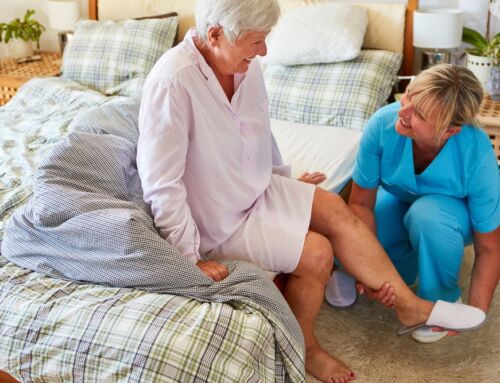With high levels of social isolation created by the pandemic, technology has become a lifeline for many seniors in the past year. Forgoing in-person visits with friends, trips to see family, and countless milestones for loved ones, seniors have been able to stay connected across the miles using technology programs like Zoom and FaceTime, plus social media platforms like Facebook.
Of course, these tools are no substitute for live human contact, but in many cases, the pandemic has forced us to embrace our relationship with technology like never before. And as more and more research reveals, seniors are ready to rise to the occasion.
Internet and social media use
Seniors’ use of the internet and social media has been trending upward for years, and according to Pew Research, the pandemic has led to even greater usage of certain online capabilities.
As of 2019, per Pew data, 72 percent of all adults in America used some sort of social media, including 69 percent of those age 50 to 64, and 40 percent of people age 65 and older. The researchers found that the most popular social media channels for older Americans were:
- YouTube, used by 70 percent of those 50 to 64, and 38 percent of those 65 and older
- Facebook, used by 68 percent of those 50 to 64, and 46 percent of those 65 and older
- Pinterest, used by 27 percent of those 50 to 64, and 15 percent of those 65 and older
- Instagram, used by 24 percent of those 50 to 64, and 8 percent of those 65 and older
While the data is still being collected, it is likely that these numbers would be even higher today since more and more people have turned to the internet for social opportunities since in-person activities have been shut down.
A March 2020 Pew survey revealed that, even early in the pandemic, 74 percent of Americans age 65 and older had used email to communicate with someone. Another Pew survey from April of last year found that among those 65 and older, 20 percent had participated in a virtual “party” or social gathering with friends or family, and 19 percent had ordered groceries or takeout from a restaurant using online technology. In all likelihood, these numbers also would be much higher a full year into the pandemic.
>> Related: Seniors and Technology- Embracing the Digital Age
Smartphone technology becoming the norm
Smartphone use is also on the rise among seniors, making the use of social media and video conferencing even easier. The apps on smartphones and tablets also give users access to a host of helpful information and tools.
An AARP survey found that between 2017 and 2019, smartphone adoption jumped from 70 percent to 77 percent among Americans age 50 and older. Those numbers have been steadily climbing over the years. Consider the fact that in 2014, when 8 in 10 younger Americans used a smartphone, only half of adults over 50 had one. Today, among Americans age 50 to 59, smartphone adoption is at 86 percent. For those between 60 and 69 years old, 81 percent have a smartphone, and 62 percent of those 70 and older use one.
>> Related: How Technology Is Reducing Long-Distance Caregiver Burden
Seniors adopting other technology, too
There are a number of other technologies that seniors have embraced, with popularity only growing since the pandemic. For example:
- Video conferencing tools like Skype, Zoom, and Apple’s FaceTime enable seniors to actually see friends and loved ones when they can’t be face-to-face. This has been a wildly popular tool for people of all ages during the pandemic.
- Tablets (like the iPad) and e-books (like the Kindle) are portable and increasingly utilized by seniors. These devices can be especially helpful for aging eyes as the text is brighter and can be magnified if needed. They also have enabled seniors to forgo trips out to the library or newsstand amid the pandemic.
- Streaming media services like Netflix, Hulu, and Apple TV have given many of us countless hours of entertainment — especially over the past year. Seniors have jumped on the streaming bandwagon too, using their smartphones, tablets, or a web-enabled TVs to view shows.
- Online educational and fitness classes have increased in popularity among seniors since last spring too, according to Pew data. Want to take yoga or learn to paint? There’s an online class for that!
- Also based on Pew research, telehealth doctors’ visits by seniors have become increasingly common since the start of the pandemic. While some medical procedures can only be done in person, online telehealth visits are useful for routine care and monitoring of certain conditions.
- Wearable technology like the Apple Watch or the Fitbit enables seniors to sync valuable information to their smartphones. Exercise data or vitals like heartrate, blood pressure, and glucose levels, can be tracked and even sent to a healthcare provider for monitoring — especially useful since some in-person doctor’s visits have been limited during the pandemic.
>> Related: The CCRC of the Future: Technology
Follow us! New videos, social media engagement for myLifeSite
While the pandemic has been the impetus for many of the increases in seniors’ technology use, these usage trends will likely continue to increase in the years to come. Here are myLifeSite, we have been closely following seniors’ technology usage data, and as a result, we recently made several enhancements to our online presence.
- We have added a number of new educational videos to our YouTube channel. These brief videos cover important topics like typical entrance qualifications at a life plan community (also called a continuing care retirement community or CCRC), residency contract models, reasons for choosing a life plan community, and more.
- We have launched a new Pinterest page, where you can find interesting facts and figures about retirement and senior living, and links to useful resources for the senior living decision process, plus other great motivational and informational pins.
- We have upped our game on other social media sites too, including Facebook, Instagram, Twitter, and LinkedIn. Be sure to follow us!
In addition, we soon will be launching myLifeSite 2.0, a complete overhaul of myLifeSite’s CCRC database and report engine. With the new website, access to our CCRC profiles will no longer require a login or payment. Additionally, you will be able to filter results based on your unique lifestyle preferences and needs.
We hope you will find these improvements helpful as you explore your senior living options.






